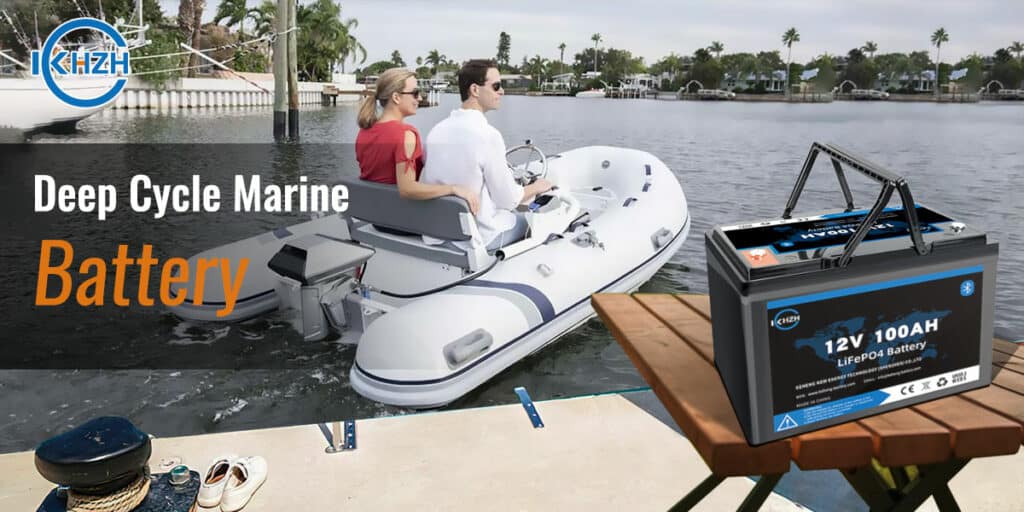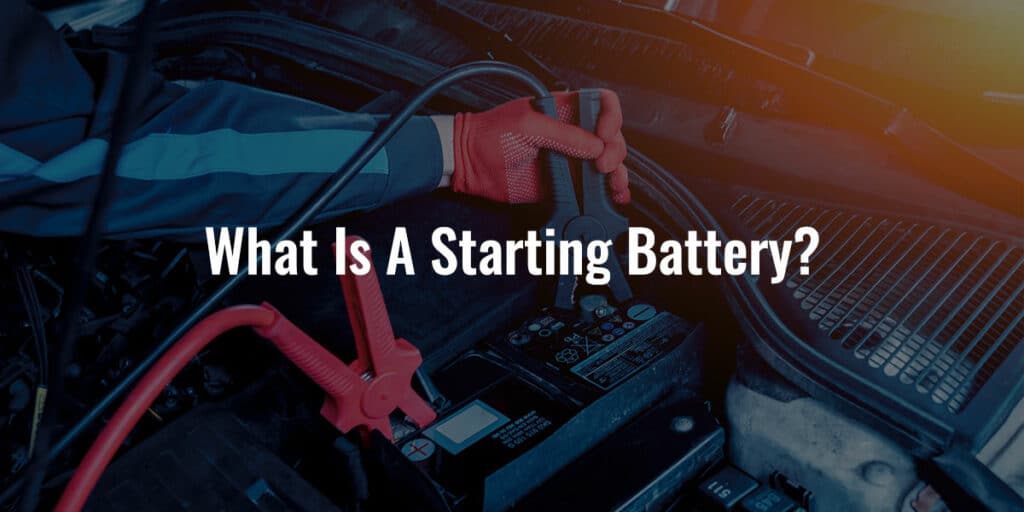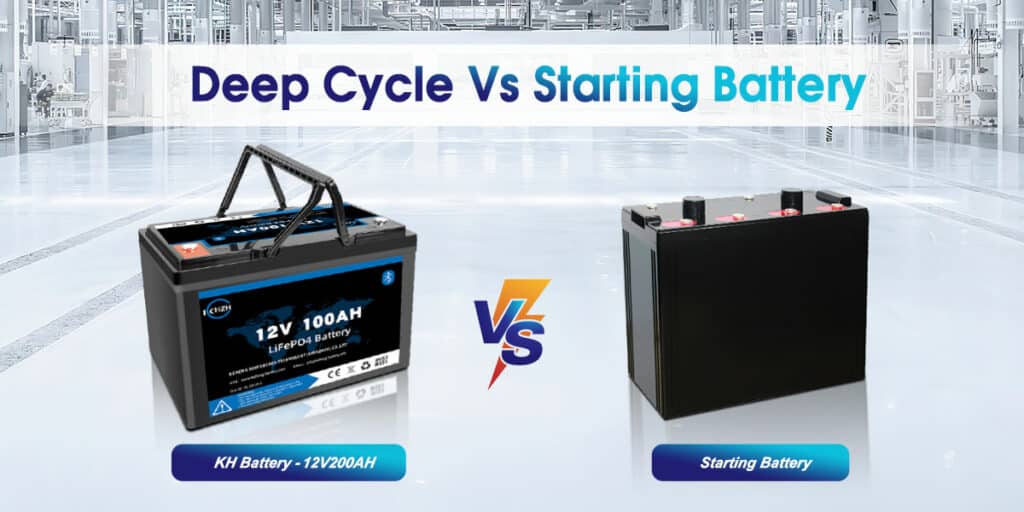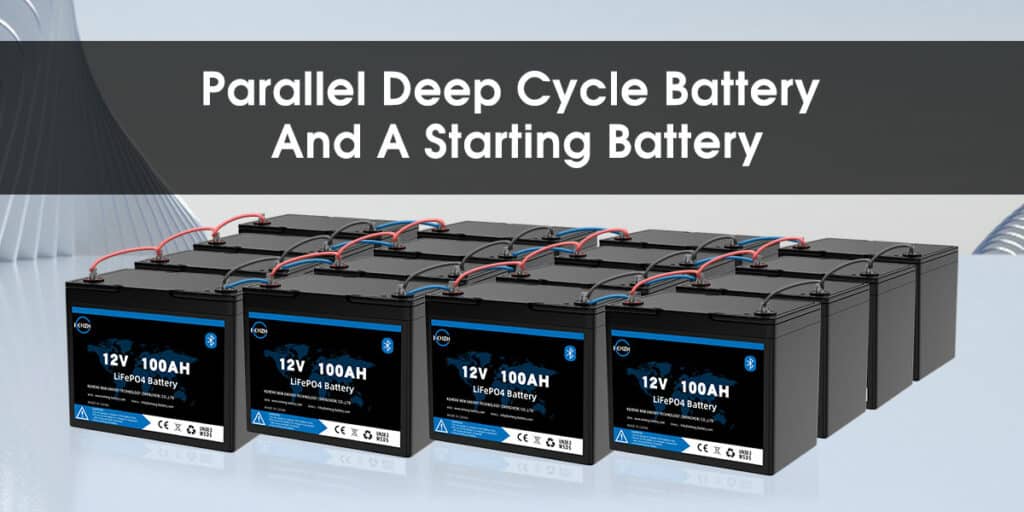Learning the difference between a Deep Cycle Marine Battery and a starting battery is very important, particularly for anglers. Your choice can affect your success, and more importantly, safety when operating a boat. However, understanding the difference between these two battery types is much easier said than done. So, keep reading to learn these differences, and what battery type is right for you and your goals.
What is the Deep Cycle Marine Battery?

Deep Cycle Lithium Batteries are batteries designed to withstand consistent charging and discharging at high levels without damaging or shortening the battery’s lifespan. In fact, some deep-cycle batteries are capable of being drained to 10% of their capacity without harming their longevity. In terms of power, deep cycle batteries will provide a steady, predictable amount of power over a long period.
You may hear a deep cycle lithium battery being called a marine battery, a house battery, or an SLA battery.
What is a Starting Battery?

Starting batteries, on the other hand, are designed for short, sharp bursts of energy that dissipate very quickly. These bursts of energy will only discharge the battery by a few percent at most, but will not last nearly as long as a deep cycle battery’s output.
Starting batteries are most often found in cars. When the ignition is turned on, the battery provides a huge surge of power to turn the engine over for the first time. Then, the alternator kicks in and eventually takes over.
Deep Cycle Vs Starting Battery

Deep cycle lithium batteries and starting batteries are essentially opposites of one another, and where one shines, the other falters.
Starting batteries are most useful for delivering short bursts of energy, like starting an engine. However, they struggle to deliver constant energy for a prolonged period of time.
On the other hand, deep cycle batteries are excellent at delivering consistent, predictable power and can discharge to incredibly high levels. But, if you need to deliver a burst of high-voltage energy, a deep cycle battery won’t be very useful.
Extended Reading
What Are The 11 Best Deep Cycle Marine Batteries?
Can I Use Deep Cycle Battery for Starting?
In theory, you should be able to use a deep cycle lithium battery for starting. It has the capacity to provide the short burst of energy needed to turn the engine over and ultimately get your boat running.
However, this is not generally a good idea. A deep cycle battery is simply not designed for starting, and by using it for this purpose, you run the risk of damaging your battery beyond repair, damaging other electrics in your boat, and even void the warranty of your battery and any other electronics. Therefore, you should only use a deep cycle lithium battery for starting when you have absolutely no other choice.
Can I Run a Deep Cycle Battery and a Starting Battery in Parallel?

Theoretically speaking, you can run a deep cycle battery and a starting battery in parallel. However, as with using a deep cycle battery for starting, this is a terrible idea in practice. The reasons for this are twofold.
Firstly, the starter battery will become more deeply discharged when run in parallel with deep cycle lithium marine batteries. On the other hand, the deep cycle battery will have to cope with voltages that it’s not designed for, thus causing unnecessary wear and tear.
If you do want to run a deep cycle battery and a starting battery in parallel, it’s a good idea to invest in a split charger. This device will join the two batteries in parallel but will disconnect the deep cycle lithium battery when starting the engine. Similarly, when the engine is switched off, the starter battery will be turned off.
Why Are Lithium Deep Cycle Batteries Better?
If you’ve answered the question of deep cycle vs. starting battery and opted for the former, you may be wondering which type of deep cycle battery is better. There are two main options- lead-acid and lithium-ion. Lithium ion batteries are seen as superior in virtually every way.
Firstly, deep cycle lithium batteries generally provide between 20-50% more battery capacity than lead-acid counterparts, meaning you can power your boat and other appliances for far longer. If operational time is high on your priority list, then lithium-ion batteries are certainly the better choice.
Lithium-ion batteries also have a much higher depth of discharge than lead-acid batteries, meaning that they need less overall charging time and are far more practical as a result- particularly for anglers.
However, lithium-ion batteries will likely cost much more upfront than their lead-acid counterparts. However, over time, it will be a more cost-effective investment, as lithium batteries can run for up to 5,000 more cycles than a lead-acid counterpart.
How Many Sizes for the Deep Cycle Battery?
| Group Size | Length (in) | Width (in) | Height (in) | Capacity (Ah) |
| Group 22 | 7.68 | 5 | 6.75 | 35-40 |
| Group 24 | 10.2 | 6.8 | 9.3 | 60-75 |
| Group 26 | 12.19 | 6.8 | 7.5 | 70-80 |
| Group 27 | 11 | 7.3 | 9.3 | 75-90 |
| Group 31 | 13 | 6.75 | 9.5 | 85-100 |
| Group 35 | 10.75 | 7 | 7.75 | 75-85 |
| Group 36 | 12.5 | 6.8 | 7.5 | 90-100 |
| Group 40 | 12.19 | 6.8 | 9.38 | 95-105 |
| Group 41 | 12.19 | 6.8 | 9.38 | 95-105 |
| Group 46 | 12.19 | 6.8 | 9.38 | 95-105 |
| Group 48 | 13 | 6.8 | 9.38 | 100-110 |
| Group 51 | 12.94 | 7 | 9.63 | 110-120 |
| Group 65 | 18.94 | 7.56 | 9.63 | 160-170 |
Extended Reading
BCI Battery Group Size
What does Group 31 in deep cycle batteries mean?
In total, there are three different sizes of lithium marine batteries to choose from. These are: 24, 27 and 31.
Group 24 lithium marine batteries measure 10.2 inches in length, 9.3 inches in height, and 6.8 inches and width. Many options in this class will be an 800 cranking amp battery or higher. Group 24 batteries ultimately offer great power in a compact battery and are most suitable for smaller boats.
The next step up is the group 27 battery. Batteries in this class measure 11 inches in length, 9.3 inches in height, and 7.3 inches in width. Group 27 deep cycle lithium batteries are the most common lithium marine batteries on the market, and offer a great step up in power from group 24 batteries, without compromising heavily on size.
The final class of battery is the group 31 battery. Batteries in this class are much bigger and heavier, measuring 12.8 inches in length, 9.3 inches in height, and 6.8 inches in width. Every option in this class will be an incredibly high-cranking amp battery and will be able to handle a variety of added tasks such as air conditioning and even cooking appliances. So, if you want the most powerful deep cycle lithium battery money can buy, your best option is a size 31.
FAQ About Deep Cycle Marine Battery
Can I Run a Deep Cycle Battery and a Starting Battery in Parallel?
You can run a starting battery and a deep cycle lithium battery in parallel, and they will work together. However, this isn’t a great idea because you will actually end up damaging both batteries over time. This is because a deep cycle battery isn’t designed to withstand the voltage that a starting battery requires, and a starting battery isn’t designed to be as deeply discharged as a deep cycle battery.
Running two identical batteries in parallel is therefore a much better choice. Alternatively, invest in a split charger.
How Long Do Lithium Marine Batteries Last
Good lithium-marine batteries should last you at least three to five years. However, how long your battery survives really comes down to its internal quality, how you maintain it, and the climate you’re in.
To increase the lifespan of your lithium-marine battery, it’s a good idea to try to keep its charge level above 50%. This will avoid any unnecessary wear and tear, increasing the battery’s overall longevity.
Why are Deep Cycle Batteries Better?
Deep cycle lithium batteries are superior to starting batteries for a few reasons. Primarily, a deep cycle battery provides much more sustained power than a starting battery, allowing you to run your boat for longer journeys. Deep cycle batteries are also noticeably smaller than starting batteries, making them better suited for recreational type-vehicles like angling boats.
What is the Difference Between a Group 24 and Group 27 Marine Battery?
The main difference between a Group 24 and Group 27 Marine battery is the size. Group 27 batteries are just under one inch longer both length and width. Group 27 batteries are also a little bit more powerful than Group 24 batteries, and are therefore suited to bigger and more energy-hungry boats.





